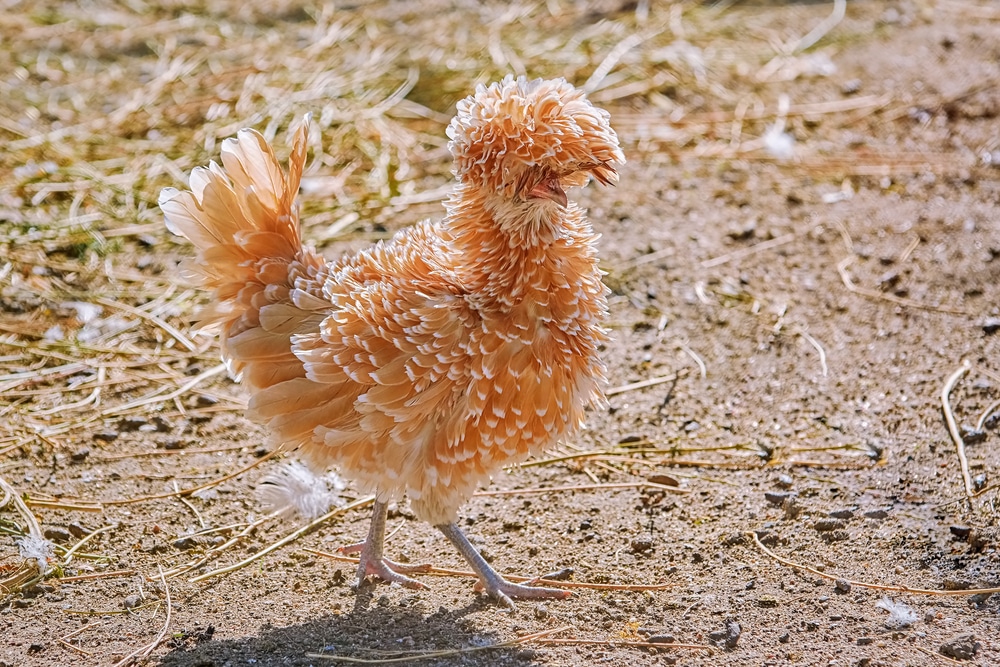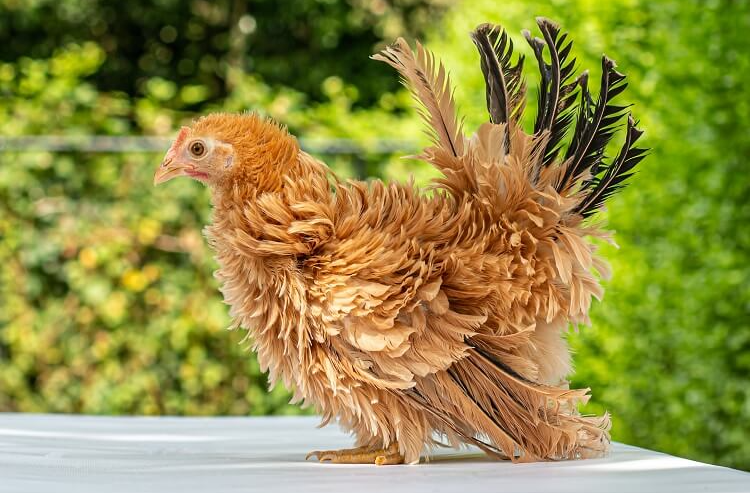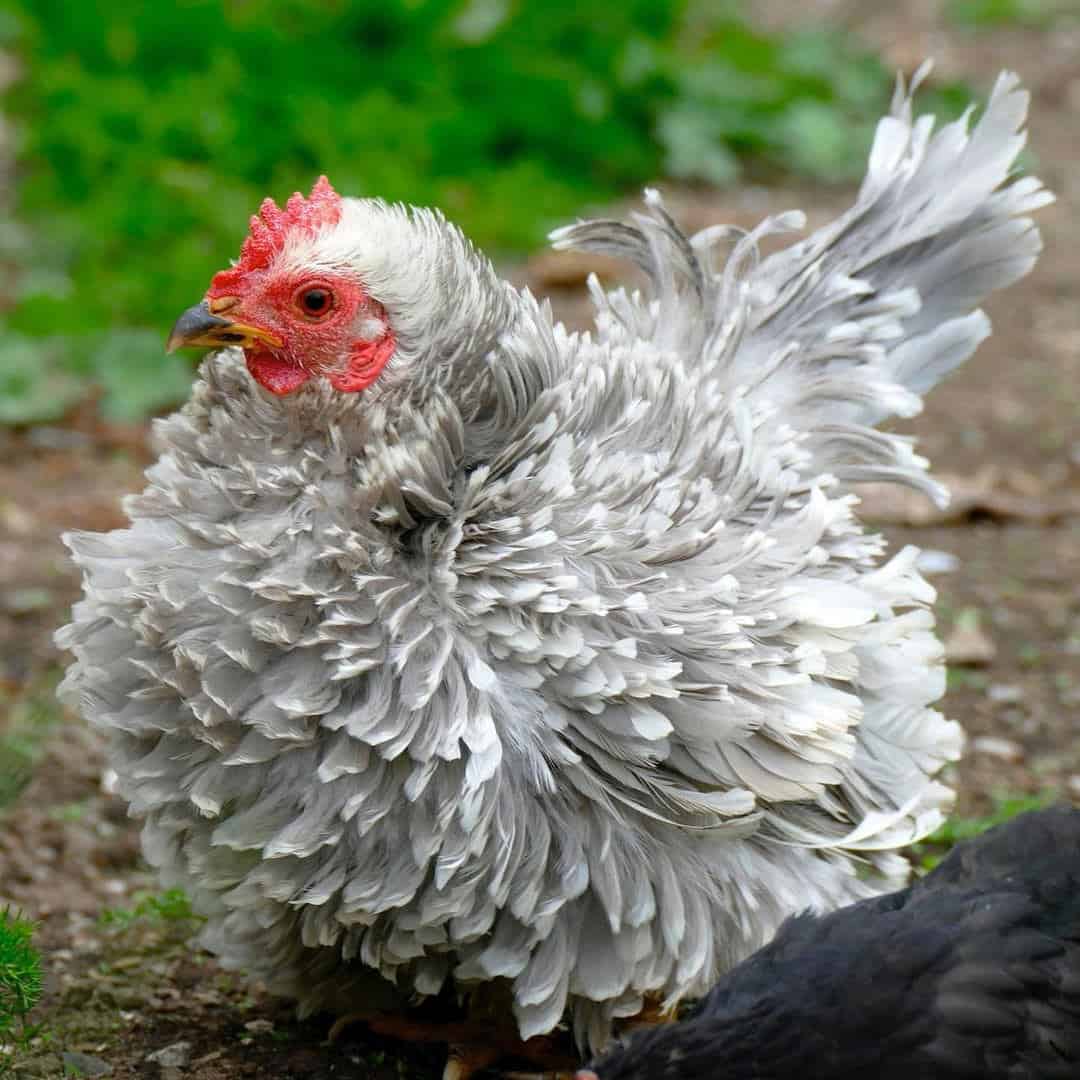Frizzle Chicken - Your Guide To These Curly-Feathered Friends
Have you ever caught sight of a chicken with feathers that seemed to defy gravity, perhaps curling outwards in a most charming way? If so, you were probably looking at a frizzle chicken, a truly unique bird that captures the eye and, quite honestly, melts the heart of anyone who sees them. These birds are something of a delightful surprise in the world of backyard poultry, offering a distinct look and a personality that many find quite endearing. We are going to explore what makes these birds so special, from their unusual appearance to their friendly ways, giving you a good idea of what to expect if you are thinking of adding one to your flock.
You know, it's pretty fascinating how a simple genetic quirk can create such a noticeable difference in an animal, and with the frizzle chicken, it's all about those feathers. They don't just lie flat like on most chickens; instead, they gently curve away from the body, giving the bird a sort of windswept, almost fluffy appearance. This particular trait is what makes them stand out in any group of birds, and it is that very feature that draws people in, making them a sought-after addition for many who appreciate a little something different in their garden. They are, in a way, like the living embodiment of a good hair day, every single day.
What's really interesting about the frizzle chicken is that they are not, strictly speaking, a breed all on their own. Instead, they are more like a feather style that can show up in many different kinds of chickens. You might find this curly feathering on birds that are otherwise Cochins, or maybe Polish, or even Orpingtons, just to name a few. This means that while they all share that wonderfully curled plumage, the underlying chicken itself might have its own distinct characteristics, like size or typical egg output. It's almost like a special outfit that can be worn by various individuals, making each one a bit special.
- What Does Bella Robertson Do For A Living
- 2 Babies One Fox Comic
- Chicago
- 51%C3%A5%C6%92%C3%A7%C5%93%C3%A5%C3%A5
- Frank Gallagher Shameless
Table of Contents
- What Makes a Frizzle Chicken Special?
- Where Do Frizzle Chickens Come From?
- How to Care for Frizzle Chickens?
- Are Frizzle Chickens Good Backyard Birds?
What Makes a Frizzle Chicken Special?
When you first lay eyes on a frizzle chicken, the very first thing that catches your attention is, without a doubt, their feathers. They truly stand out from the usual chicken crowd, and that's precisely why so many people are drawn to them. It's not just that they're pretty; there's a certain charm to their slightly disheveled yet organized look. These birds have a way of looking both unique and somehow quite cuddly all at once, which makes them a popular choice for folks who enjoy having something a little different running around their yard. You know, they are pretty much always a conversation starter.
The Unique Look of the Frizzle Chicken
The appearance of a frizzle chicken is, well, pretty distinctive. Instead of the smooth, flat feathers you typically see on most chickens, these birds have plumage that curls upwards and outwards. It gives them a rather fluffy, almost windswept kind of look, like they've just stepped out of a gentle breeze. This feathering can be quite dense, making them appear a bit rounder or fuller than their smooth-feathered relatives. Sometimes, people even describe their feathers as having a hair-like quality, which just adds to their unusual appeal. It's almost as if each feather decided to have its own little curl, rather than lying flat with its neighbors, making for a truly eye-catching sight.
This particular feather arrangement isn't just for show; it's a key part of what makes a frizzle chicken, a frizzle chicken. You'll find these birds come in a whole rainbow of colors, too, just like other chickens. So, you might see a black one with curly feathers, or a white one, or even a mix of colors. The curl itself is what defines them, not the specific shade of their plumage. They often have a somewhat exotic feel to them, yet they are just as much a chicken as any other, just with a very special coat. They are, in some respects, living works of art for the backyard.
Is a Frizzle Chicken a True Breed?
It's a common thought that a frizzle chicken is its own distinct breed, but that's not quite the whole story. Actually, the term "frizzle" refers more to a feather type or a genetic trait rather than a standalone breed. Think of it this way: it's like having curly hair versus straight hair on a person; it's a characteristic, not a different kind of human. So, what you're really seeing is a chicken from a known breed, like a Cochin or a Polish, that also happens to carry the frizzle gene. This means that a frizzle chicken can come in all sorts of shapes and sizes, depending on the underlying breed it belongs to. You know, it's a bit like a special edition of a car, where the engine is the same but the exterior has a unique finish.
You can find the frizzle feathering on a whole range of popular chicken breeds. For example, you might see a Cochin frizzle, which combines the large, fluffy body of a Cochin with the unique curly feathers. Or perhaps a Polish frizzle, which would have both the crest of feathers on its head and the all-over curl. Other breeds where this trait often shows up include Plymouth Rocks, Japanese Bantams, Araucanas, Orpingtons, and even Silkie chickens. The frizzle gene simply gives these existing breeds a wonderfully distinctive look, making them even more charming. It's pretty cool how one gene can change so many different birds, actually.
Where Do Frizzle Chickens Come From?
The story of the frizzle chicken is quite an interesting one, rooted in a simple, yet powerful, genetic change. It's not something that was created recently; these birds have been around for a good while, captivating people with their unusual appearance. Their history is tied to how this specific feather type came about and how it spread among different chicken populations. You know, it's kind of neat to think about how something so distinctive started from just a tiny variation in nature.
The Genetic Secret of Frizzle Chicken Feathers
The reason a frizzle chicken has those wonderfully curly feathers is all down to a specific genetic condition. There's a particular gene, often referred to as the 'F' gene, that causes the feathers to curl outwards instead of lying flat against the bird's body. This gene affects the keratin, which is the main protein that makes up feathers. Instead of forming straight, smooth shafts, the keratin in a frizzle chicken's feathers develops in a way that makes them curve and bend. This is an incomplete dominant gene, meaning that even having just one copy of this gene is enough for a chicken to display the frizzled look. So, if a chicken inherits just one 'F' gene from either parent, it will have those characteristic curly feathers. It's pretty straightforward, in a way.
However, there's a bit more to this genetic story. While one copy of the frizzle gene gives you a lovely frizzle chicken, what happens if a chicken inherits two copies of this gene, one from each parent? In that situation, the bird will have what's often called a "frazzle." Frazzles have feathers that are even more curled, sometimes to the point of being quite brittle or sparse. Their feathering might not provide as much insulation or protection, which can sometimes lead to health issues, especially in colder weather. Many people who raise chickens consider breeding for frazzles to be something that isn't really responsible, because of the potential health problems for the bird. It's a bit of a delicate balance, you see, ensuring the birds are healthy while still appreciating their unique looks.
A Peek into Frizzle Chicken History
The frizzle chicken isn't a new invention; these birds have a pretty long and interesting history. Records of chickens with curled feathers go back quite a ways, with mentions of them appearing in various parts of the world, including Asia and Europe, centuries ago. It's believed that the trait likely originated in Southeast Asia, where it might have naturally occurred and then spread through trade and breeding. People probably noticed these unusual birds and, being drawn to their unique appearance, started to keep and breed them, helping to spread the frizzle gene around the globe. They were, in a way, exotic curiosities that became beloved additions to flocks.
Over time, as chicken breeding became more organized, the frizzle trait was recognized and incorporated into different existing breeds. This is why, as we mentioned, you can find frizzle chickens that are essentially Cochins or Polish or other types of birds, just with that special curly feathering. They've been admired for their distinctive look for a very long time, and their friendly personalities have only added to their appeal as pets and exhibition birds. Their story is a good reminder of how much variety there is in the animal kingdom, and how a simple genetic difference can create something truly wonderful, really.
How to Care for Frizzle Chickens?
Caring for a frizzle chicken is, for the most part, quite similar to looking after any other chicken. They need the same basic things: good food, fresh water, a safe place to sleep, and room to move around. However, because of their unique feathering, there are a few small things to keep in mind to make sure they stay happy and healthy. You know, a little extra consideration can go a long way in making sure these special birds thrive.
Keeping Your Frizzle Chicken Happy and Healthy
One of the main things to remember about frizzle chicken care is their feathers. Because they curl outwards, these feathers might not offer as much protection from the elements as typical smooth feathers do. This means they can be a bit more sensitive to very cold or very wet weather. If you live in an area with harsh winters, you might need to give your frizzle chickens extra shelter or consider providing a bit of warmth in their coop. Similarly, if it's really rainy, they might get waterlogged more easily, so a dry, covered area for them to escape to is a good idea. It's almost like they need a rain jacket more than other chickens, in a way.
Their unique feathers can also make them a little more prone to getting dirty or having things caught in their plumage. So, keeping their living area clean and dry is pretty important. Regular checks of their feathers for any build-up or parasites can also help keep them comfortable. Beyond that, their dietary needs are standard for chickens; a good quality layer feed, plenty of fresh water, and perhaps some treats will keep them well-nourished. They are, essentially, chickens with a special coat that just needs a little extra thought, really.
Frizzle Chicken Temperament and Living with Them
When it comes to their personality, frizzle chickens are often described as being quite friendly and calm. They tend to have a very gentle disposition, which makes them lovely additions to a backyard flock, especially if you have children. They are typically not aggressive and can become quite tame, often enjoying interaction with people. This makes them good pets and educational companions for young ones who are learning about animals. You know, they are quite often the stars of the flock because of their easy-going nature.
Because of their sweet and friendly ways, they usually get along well with other chickens in a mixed flock. However, like with any group of animals, it's always a good idea to introduce new birds slowly and watch for any signs of pecking order adjustments. Their somewhat vulnerable feathering might mean they are not as robust in a very rough pecking order, but generally, their calm nature helps them fit in. They are, in some respects, the gentle souls of the chicken world, making them a joy to have around. They really do bring a lot of charm to any setting.
Are Frizzle Chickens Good Backyard Birds?
For many people considering chickens for their backyard, the frizzle chicken is a really appealing option. Their distinctive looks certainly draw attention, but it's their combination of unique appearance and friendly nature that often seals the deal. They can be a wonderful addition, bringing both visual interest and a pleasant demeanor to your outdoor space. You know, they are quite often considered a favorite for those who want something a little out of the ordinary but still practical.
Frizzle Chicken Egg Laying and Productivity
When it comes to egg production, the frizzle chicken's output really depends on the underlying breed it carries. Since "frizzle" is a feather type and not a breed, a frizzle Cochin will lay eggs similar to a regular Cochin, and a frizzle Polish will lay eggs like a regular Polish. Some of the breeds that commonly carry the frizzle gene, like Orpingtons or Plymouth Rocks, are known for being pretty good layers. So, you can expect a reasonable number of eggs, typically medium to large in size, depending on the specific parent breed. They are, in a way, just as productive as their non-frizzled counterparts, which is pretty convenient.
It's important to remember that while they might not be the absolute top egg producers compared to specialized laying breeds, they certainly contribute to the breakfast table. Their primary appeal, for many, is their appearance and temperament, with egg laying being a nice bonus. They are more than just pretty faces; they can be productive members of your flock, providing fresh eggs while also being delightful to watch. So, you know, they offer a good balance of looks and utility for the backyard chicken keeper.
Buying and Showing Your Frizzle Chicken
If you're thinking about adding a frizzle chicken to your flock, you'll find them available from various sources. You can often find them through specialized breeders who focus on specific chicken varieties, or sometimes at local farm supply stores or poultry swaps. When buying, it's a good idea to look for reputable sellers who can tell you about the bird's parentage and health. You want to make sure you're getting a healthy bird that has been cared for properly. It's almost like doing a bit of research before making any big purchase, really.
For those interested in showing chickens, frizzle chickens can be quite popular in poultry shows. Their unique appearance makes them stand out, and many people enjoy showcasing their well-cared-for birds. If you plan to show your frizzle chicken, you'll want to learn about the specific standards for the breed it represents, as well as how the frizzle trait is judged. It's a fun way to share your passion for these unique birds and connect with other poultry enthusiasts. You know, it's a bit like entering a beauty contest, but for chickens.
Understanding Frazzles and Sizzles in Frizzle Chicken Lines
When you talk about frizzle chickens, you might also hear terms like "frazzles" and "sizzles," and it's good to know what these mean. As we touched on earlier, a "frazzle" is a chicken that has two copies of the frizzle gene. This results in feathers that are extremely curled, often to the point of being sparse or brittle. While they are still frizzle chickens, their feathering can be a bit more fragile and might not offer as much protection. Breeders usually avoid purposefully breeding frazzles because of the potential health issues for the bird. It's a situation where too much of a good thing can actually be a problem, you see.
A "sizzle" is a specific type of frizzle chicken: it's a frizzle that has Silkie chicken in its background. Silkie chickens are already quite unique, with their fluffy, hair-like feathers, five toes, and dark skin. When the frizzle gene is introduced to a Silkie, the resulting bird, a sizzle, has an even more pronounced and wonderfully soft, curly appearance. Sizzles are very popular and highly sought after because they combine the charming qualities of both the Silkie and the frizzle. They are, in a way, the ultimate fluffy, curly chicken, making them incredibly appealing to many chicken lovers. They really are something special to behold.
So, there you have it: a look into the world of the frizzle chicken. We've talked about their distinct appearance, how their curly feathers come from a unique genetic trait, and how they are more of a feather style than a standalone breed. We also covered what makes them such friendly and charming additions to a backyard flock, and some simple tips for keeping them well. From their history to their care, and even the nuances of frazzles and sizzles, these birds are truly fascinating and bring a lot of character to any setting.

Frizzle Chicken Breed Guide - Know Your Chickens

Frizzle Chickens - A Guide to the Fun Chicken Breed | Somerzby

Polish Frizzle Chicken